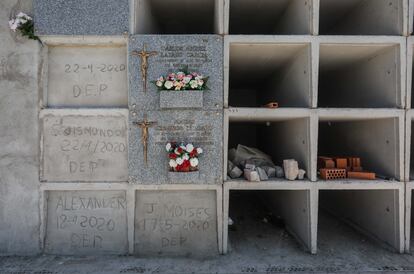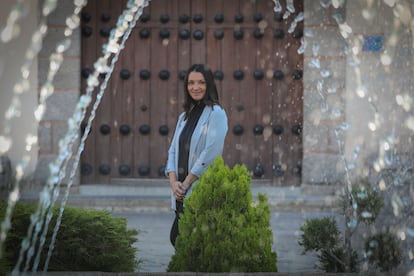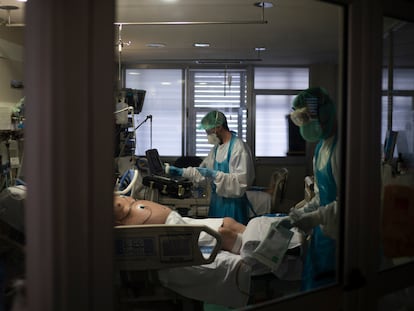The Spanish village that ran out of space for its dead
The cemetery of San Martín de Valdeiglesias was overwhelmed during the first Covid-19 wave. Now, local officials are rushing to create more space amid growing fears of new fatalities


The five bodies were being stored in the funeral home while a crew of laborers was working flat out to build a row of niches – above-ground burial spaces. The dead were waiting for the construction work to end, like a married couple who has purchased an off-plan apartment. The niches would be their last resting places, as soon as they were finished.
Cemeteries like this one, in San Martín de Valdeiglesias, have been overwhelmed by the Covid-19 pandemic. The local council of this village, which sits on the western border of the Madrid region with the province of Ávila, had to build 24 vertical cavities to accommodate the remains of coronavirus victims. There were no empty graves left.
Residents began to understand the magnitude of the tragedy when, from one day to the next, César disappeared from their lives. He was a 50-year-old man with Down syndrome, and was held in great affection by the locals. He would sometimes serve as an altar boy during Mass, or bang a drum in the municipal band, or stand in the front line of an official event held by the mayor. They say that he had a talent for ubiquity.
The laborers had to build a row of niches as fast as possible. The undertakers laid the first coffins there while the cement was still fresh
César got sick in March. His mother, whom he slept next to since the day he was born, also got infected. On March 25, she passed away. Just three hours later, César was gone too. They buried them together in the same grave after a discreet ceremony. In other circumstances, César would have had a funeral fit for a pharaoh.
After that, the deaths arrived in a torrent: 133 from a population of 8,500 inhabitants, which works out at 1.5% of the total. Many of the victims were living in the three senior residences and two centers for people with learning disabilities. But the virus also spread among residents of the old quarter of the town, and ended the lives of some of the oldest locals – some aged over a hundred.
When she assumed her role more than a year ago, Mayor Mercedes Zarzalejo realized that there was barely any space left in the cemetery. In the summer of 2019, she ordered the construction of eight tombs, each of which could hold five coffins. “That will be enough for a couple of years,” she thought at the time. She couldn’t have imagined what was to come. The spread of a virus that began on the other side of the world spoiled those plans. Before long, all of the empty graves were filled and the deaths kept coming. The laborers had to build a row of niches as fast as possible. The undertakers laid the first coffins there while the cement was still fresh.

This vertical form of burials, which is very common in Spanish cities such as Madrid, is not the norm in many towns and villages – at least not in San Martín. The municipal authorities met resistance from families at first, who said that they wanted their loved ones laid to rest in the ground, as is customary. Some agreed to a niche, provided that the remains would be transferred once there was a grave available.
“There was a time when I started to obsess over it,” explains the mayor from her office. “At the start of the year there was a niche and a grave still available. But then Covid arrived and people started to die. Suddenly we had coffins piling up in the freezers in the morgue. You can’t sleep when something like that happens.”
Before the cemetery can be enlarged, the mayor will need a subsidy from the Madrid regional government to erect a containing wall. Without it, the earth would move and there could be a landslide – the coffins would move as if they were flowing down a river.
While the paperwork is processed to secure that assistance, Zarzalejo has since built another eight tombs, the same number as a year ago. To cover that cost she used the money that would have been spent on the local fiestas, which in a normal year would be the biggest social event in the area. Some have accused her of diverting money that should be spent on culture to funeral services instead.
If we had another wave of the virus I don’t know what we would do. There’s no room for more dead hereMayor Mercedes Zarzalejo
In the cemetery, some of the niches had the date of death scrawled into the wet concrete: 11-6-2020, 20-5-2020… Some of them have first names, such as Segismundo or Alexander. They were residents of a Madrid regional center that housed former prisoners, addicts, the homeless and people with mental illness at the end of their lives. The majority of them pass away without having contact with their relatives, and once it has been established that no one will take charge of their remains, the council covers the cost of a burial. Their bodies were the ones that spent the longest time in the freezers. From now on, anyone that passes away in similar circumstances will be buried in a shared site. “We have approved the construction of a mass grave,” explains the mayor. "We are doing it now. I copied an example from Madrid City Hall, where they did this too. Sixteen will fit there.
“If we had another wave of the virus I don’t know what we would do,” she adds. “There’s no room for more dead here.”
The cemetery in San Martín de Valdeiglesias had reached capacity not just due to the bodies already buried there, but also because of the graves that have been reserved decades ahead of time by those that will one day be laid to rest there. A wander around the site reveals granite tombstones decorated with flowers that contain no coffins. They are empty. Inscriptions read, for example, Sánchez García, in reference to a family who has already purchased a plot. The mayor has now prohibited this practice. Families who want to pay for a grave must first have a body to fill it with.
The first gravestone in the cemetery belongs to someone named Felicísimo. His name is carved into a marble headstone. It’s a privileged spot, the first one that visitors come to upon entering. But Felicísimo is alive and kicking. “Yes, I am,” he confirms over the phone. He’s 95 years old, and he was the parish priest until he retired in 2004 and went to live in a residence.
It wasn’t his idea to place his name on a tombstone ahead of his death – it was done by his replacements, in good faith as far as he understands. He’s uncomfortable with the grave site, because he has met many people during his long life and some could mistakenly believe that he is no longer with us. He’s not sure if that’s why he no longer receives so many visitors – just a handful of his former students and his ex-driver. The most famous man in the cemetery proposes a date: “Come visit me whenever you like.”
English version by Simon Hunter.
Tu suscripción se está usando en otro dispositivo
¿Quieres añadir otro usuario a tu suscripción?
Si continúas leyendo en este dispositivo, no se podrá leer en el otro.
FlechaTu suscripción se está usando en otro dispositivo y solo puedes acceder a EL PAÍS desde un dispositivo a la vez.
Si quieres compartir tu cuenta, cambia tu suscripción a la modalidad Premium, así podrás añadir otro usuario. Cada uno accederá con su propia cuenta de email, lo que os permitirá personalizar vuestra experiencia en EL PAÍS.
¿Tienes una suscripción de empresa? Accede aquí para contratar más cuentas.
En el caso de no saber quién está usando tu cuenta, te recomendamos cambiar tu contraseña aquí.
Si decides continuar compartiendo tu cuenta, este mensaje se mostrará en tu dispositivo y en el de la otra persona que está usando tu cuenta de forma indefinida, afectando a tu experiencia de lectura. Puedes consultar aquí los términos y condiciones de la suscripción digital.
More information
Últimas noticias
Most viewed
- Reinhard Genzel, Nobel laureate in physics: ‘One-minute videos will never give you the truth’
- Oona Chaplin: ‘I told James Cameron that I was living in a treehouse and starting a permaculture project with a friend’
- Pablo Escobar’s hippos: A serious environmental problem, 40 years on
- Why we lost the habit of sleeping in two segments and how that changed our sense of time
- Charles Dubouloz, mountaineering star, retires at 36 with a farewell tour inspired by Walter Bonatti









































